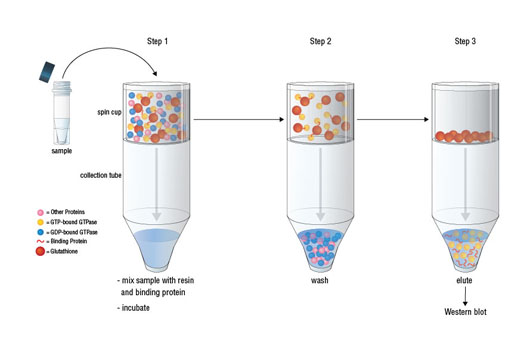#P01112
3265
Product Information
Storage
GDP: Store at -80°C
GST-Raf1-RBD: Store at -80°C
Lysis/Binding/Wash Buffer: Store at 4°C
Glutathione Resin: Store at 4°C
SDS Sample Buffer: Store at 4°C
Spin Cup and Collection Tubes: Store at RT
Ras Mouse mAb: Store at 4°C
Specificity / Sensitivity
Product Description
Background
The Ras superfamily of small GTP-binding proteins (G proteins) comprise a large class of proteins (over 150 members) that can be classified into at least five families based on their sequence and functional similarities: Ras, Rho, Rab, Arf, and Ran (1-3). These small G proteins have both GDP/GTP-binding and GTPase activities and function as binary switches in diverse cellular and developmental events that include cell cycle progression, cell survival, actin cytoskeletal organization, cell polarity and movement, and vesicular and nuclear transport (1). An upstream signal stimulates the dissociation of GDP from the GDP-bound form (inactive), which leads to the binding of GTP and formation of the GTP-bound form (active). The activated G protein then goes through a conformational change in its downstream effector-binding region, leading to the binding and regulation of downstream effectors. This activation can be switched off by the intrinsic GTPase activity, which hydrolyzes GTP to GDP and releases the downstream effectors. These intrinsic guanine nucleotide exchange and GTP hydrolysis activities of Ras superfamily proteins are also regulated by guanine nucleotide exchange factors (GEFs) that promote formation of the active GTP-bound form and GTPase activating proteins (GAPs) that return the GTPase to its GDP-bound inactive form (4).
The 21 kDa guanine-nucleotide binding proteins (K-Ras, H-Ras, and N-Ras) cycle between active (GTP-bound) and inactive (GDP-bound) forms (5). Receptor tyrosine kinases and G-protein-coupled receptors activate Ras, which then stimulates the Raf-MEK-MAPK pathway (6-8). GAP proteins normally facilitate the inactivation of Ras. However, in 30% of human tumors, point mutations in Ras prevent the GAP-mediated inhibition of this pathway (9). The most common oncogenic Ras mutation found in tumors is Gly12 to Asp (G12D), which prevents Ras inactivation, possibly by increasing the overall rigidity of the protein (9,10).
- Takai, Y. et al. (2001) Physiol Rev 81, 153-208.
- Colicelli, J. (2004) Sci STKE 2004, RE13.
- Wennerberg, K. et al. (2005) J Cell Sci 118, 843-6.
- Vigil, D. et al. (2010) Nat Rev Cancer 10, 842-57.
- Boguski, M.S. and McCormick, F. (1993) Nature 366, 643-54.
- Avruch, J. et al. (1994) Trends Biochem Sci 19, 279-83.
- Buday, L. and Downward, J. (1993) Cell 73, 611-20.
- Huang, D.C. et al. (1993) Mol Cell Biol 13, 2420-31.
- Bos, J.L. (1989) Cancer Res 49, 4682-9.
- Ma, J. and Karplus, M. (1997) J Mol Biol 274, 114-31.
Species Reactivity
Species reactivity is determined by testing in at least one approved application (e.g., western blot).
Cross-Reactivity Key
H: human M: mouse R: rat Hm: hamster Mk: monkey Vir: virus Mi: mink C: chicken Dm: D. melanogaster X: Xenopus Z: zebrafish B: bovine Dg: dog Pg: pig Sc: S. cerevisiae Ce: C. elegans Hr: horse GP: Guinea Pig Rab: rabbit All: all species expected
Trademarks and Patents
使用に関する制限
法的な権限を与えられたCSTの担当者が署名した書面によって別途明示的に合意された場合を除き、 CST、その関連会社または代理店が提供する製品には以下の条件が適用されます。お客様が定める条件でここに定められた条件に含まれるものを超えるもの、 または、ここに定められた条件と異なるものは、法的な権限を与えられたCSTの担当者が別途書面にて受諾した場合を除き、拒絶され、 いかなる効力も効果も有しません。
研究専用 (For Research Use Only) またはこれに類似する表示がされた製品は、 いかなる目的についても FDA または外国もしくは国内のその他の規制機関により承認、認可または許可を受けていません。 お客様は製品を診断もしくは治療目的で使用してはならず、また、製品に表示された内容に違反する方法で使用してはなりません。 CST が販売または使用許諾する製品は、エンドユーザーであるお客様に対し、使途を研究および開発のみに限定して提供されるものです。 診断、予防もしくは治療目的で製品を使用することまたは製品を再販売 (単独であるか他の製品等の一部であるかを問いません) もしくはその他の商業的利用の目的で購入することについては、CST から別途許諾を得る必要があります。 お客様は以下の事項を遵守しなければなりません。(a) CST の製品 (単独であるか他の資材と一緒であるかを問いません) を販売、使用許諾、貸与、寄付もしくはその他の態様で第三者に譲渡したり使用させたりしてはなりません。また、商用の製品を製造するために CST の製品を使用してはなりません。(b) 複製、改変、リバースエンジニアリング、逆コンパイル、 分解または他の方法により製品の構造または技術を解明しようとしてはなりません。また、 CST の製品またはサービスと競合する製品またはサービスを開発する目的で CST の製品を使用してはなりません。(c) CST の製品の商標、商号、ロゴ、特許または著作権に関する通知または表示を除去したり改変したりしてはなりません。(d) CST の製品をCST 製品販売条件(CST’s Product Terms of Sale) および該当する書面のみに従って使用しなければなりません。(e) CST の製品に関連してお客様が使用する第三者の製品またはサービスに関する使用許諾条件、 サービス提供条件またはこれに類する合意事項を遵守しなければなりません。

